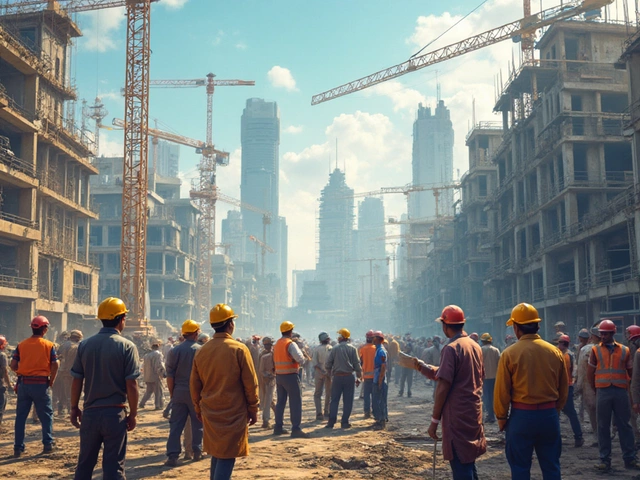Ask a real estate agent or a builder what 'new build' means and you’ll get an answer that sounds simple, but there’s more to it than meets the eye. In property talk, a new build is a home that's never been lived in before—straight from the builder, fresh paint smell, untouched carpets, the works. It could be a detached house, a flat in a new block, or even a townhouse squeezed into a city gap.
But not every sparkling house is technically a 'new build.' Sometimes the rules get a bit fussy—if a place has been rented out by the developer or sat empty for a year or two, some people will debate if it still counts as new. Usually, if no one's ever had it as their main home, it's a new build in the eyes of banks and the law.
- What Does 'New Build' Really Mean?
- How Is a New Build Different from Other Homes?
- Key Perks and Downsides of New Builds
- Tips for Buying a New Build Home
- What’s Changing in the New Build Market?
What Does 'New Build' Really Mean?
If you ask three people what a new build is, you’ll probably hear three different definitions. Here’s how it really breaks down. In the world of property and real estate, a new build is a home that’s been built from scratch, just finished, and never lived in by anyone as their main home. This isn’t a spruced-up old place or a major renovation—it’s brand-new, down to the last plug socket and kitchen cabinet.
Builders, estate agents, and even banks have specific rules for this. A new build typically means:
- The property was constructed recently (in the last two years in most cases).
- Nobody has ever owned or lived in it as their main address.
- The sale is usually from the builder or developer to the first owner.
- Sometimes, it covers homes built on new plots (“off-plan” homes) that buyers purchase before they’re even finished.
It’s not the same as a house that’s been heavily remodeled or restored. Once someone moves in and calls it home, it’s technically not a new build anymore—even if they only lived there for a few weeks.
Depending on where you are, local governments and mortgage lenders might define "new build" slightly differently. In the UK, for example, lenders will only treat a property as a new build if no one has ever lived there. In the US, builders often call anything less than a year old a new build. See how it can get confusing?
Here’s a quick reference for what counts as a new build in common scenarios:
| Scenario | Is it a New Build? |
|---|---|
| Freshly built, never lived in | Yes |
| Bought by developer, rented out | No |
| Bought & immediately listed without living in | Maybe (Check local rules) |
| Major home renovation | No |
| Brand-new, bought off-plan | Yes |
The real kicker? New builds often come with special offers you won’t find on older homes—like warranty coverage, changes to fixtures, and even government incentives sometimes. But more on that later.
How Is a New Build Different from Other Homes?
The first thing people notice about a new build is the condition—everything’s fresh off the construction line. No dents in the drywall, zero nail holes, and appliances with the stickers still on. Unlike older places, you won’t find worn-down floors, funky smells, or a garden overrun by weeds.
But it’s not just about the look. New builds also follow up-to-date building rules. This means modern insulation, energy-saving windows, and better safety features like hardwired smoke alarms. In older homes, you might have to rip out old wiring or replace thin windows just to get close to these standards.
A big perk that’s often overlooked: new build homes usually come with a warranty, which can cover repairs for 5-10 years if something major goes wrong with the structure. If a water pipe bursts in an old home, that’s on you—no warranty fairy is showing up.
Here’s a quick look at how new builds stack up against older homes:
| Feature | New Build | Older Home |
|---|---|---|
| Energy Efficiency | High (A-rated or above) | Lower (often D or below) |
| Warranty | Yes (up to 10 years) | Rare |
| Maintenance | Minimal (everything's new) | Can be high |
| Customization | Choose finishes/floorplans (early buyers) | Limited, must renovate |
On the other hand, older homes often have bigger rooms, larger gardens, and sometimes a bit more character. But if you want turn-the-key-and-live simplicity, modern features, and less hassle, it’s hard to beat what a new build offers.

Key Perks and Downsides of New Builds
If you’re eyeing a new build, the shine of being first in the door is a big pull. Everything’s unused—no weird stains, creaky stairs, or mystery smells. New homes usually come with the latest insulation, double or triple-glazed windows, and energy-saving systems that cut down your bills. Most developers also offer a warranty, such as the NHBC 10-year cover in the UK, which can be a safety net against surprises like leaks or dodgy wiring.
It’s not just about shiny appliances either. Some buyers love the blank-canvas feel; you can pick paint colors, tiles, and even kitchen styles before you move in. Not to mention, there’s no property chain to mess you around—you won’t have to deal with unpredictable sellers holding up your move.
- Energy savings: The Home Builders Federation reported in 2023 that owners of new builds paid about half as much for energy compared to owners of older homes.
- Modern safety: Smoke alarms, secure locks, and fire-resistant materials come as standard.
- Peace of mind: Under warranty, the builder fixes issues—sometimes even annoying squeaky doors or sticky windows—during the first year or two.
Still, there are trade-offs. The price for a new build is often higher than similar older houses in the same area. Many new estates also have smaller rooms and less storage—developers squeeze in as many properties as possible. If you’re hoping for a big garden or thick walls, older homes might win out. And not every builder gets it right the first time; snagging lists of faults at move-in are common, so expect to chase up for repairs.
Another thing to watch: some new builds come with service charges for things like shared gardens or private roads. These can creep up. If you plan to sell soon, you should know that new builds sometimes lose value in the first few years, a bit like a new car driving off the lot.
| Perk | Downside |
|---|---|
| Energy efficiency and lower bills | Often higher purchase price |
| Modern security features | Sometimes smaller rooms/gardens |
| Warranty against defects | Possible service charges |
| No property chain | Potential for snagging issues |
So, when looking at a new build, it pays to weigh these perks and downsides before getting blinded by the gloss. Check reviews on the builder, ask about what's covered in the warranty, and read the fine print on service charges.
Tips for Buying a New Build Home
Picking a new build might look easy, but if you skip the details, it can bite you later. Here are some solid tips to help you avoid common traps and make your move stress-free.
- Check the developer’s reputation. Search reviews, ask neighbors, and even stop by another finished site if you can. If past buyers had loads of problems, consider it a warning.
- Ask about warranties. Most new builds come with a 10-year NHBC (or similar) warranty for structure, but always ask what’s covered and what’s not. You want to know how long the builder covers snagging, like minor leaks or cracks.
- Get a snagging survey. Don’t assume new means flawless. Hire a pro for a snagging survey before you move in. They’ll spot issues you’d easily miss—like wonky windows, unfinished corners, or silly plumbing mistakes.
- Be clear on what’s included. Fittings, flooring, and even turf in the garden—these all might cost extra. Double-check the spec list so you don’t get a shock on move-in day.
- Understand the payment plan. With new builds, you might have to put down a reservation fee, pay in stages, or wait months for the keys. Read every contract line, and keep your solicitor in the loop.
- Watch out for leaseholds and service charges. Some new flats or houses come with sneaky long-term fees. Ask up-front if there’s a ground rent, service charge, or any tight restrictions on what you can do with your home.
If you care about numbers, check this out. The Home Builders Federation found that 94% of new homeowners reported snags or defects in their new build—sometimes dozens. That’s why that snagging survey pays off, big time.
| What to Check | Why It Matters |
|---|---|
| Warranty Details | Gives peace of mind (structure coverage vs. minor fixes) |
| Developer Reviews | Poor feedback? Expect delays or unfinished work |
| Extra Fees | Avoid surprise costs (parking, maintenance, upgrades) |
| Snagging Survey | Finds hidden faults before move-in |
The bottom line: Don’t just fall for shiny surfaces. Always dig into the fine print and get expert advice on any new build. It’ll save you both headaches and cash down the line.

What’s Changing in the New Build Market?
The new build scene isn’t just stuck on repeat—there’s a lot shifting lately, from prices and demand to the way these homes are built. A big thing hitting the headlines right now is how much tighter energy rules have become. Builders are being pushed to make homes more energy-efficient, so stuff like triple-glazed windows, thicker wall insulation, and better heating systems are showing up as standard, not as expensive extras. If you’re after lower utility bills, that’s great news.
Also, first-time buyer schemes are changing fast. In the UK, for example, the Help to Buy scheme closed to new applications earlier than some expected. That’s meant more competition for other first-time deals, and some buyers moving a bit quicker than planned just to lock something in. Mortgage deals for new build homes can be tighter too—banks sometimes want bigger deposits for these properties, so folks looking to buy should check out the fine print before falling in love with a shiny new house.
Supply chain problems from the past couple of years still haven’t totally cleared up. Builders face higher costs for materials like timber and steel, which can mean slightly higher prices for buyers or some delays in move-in dates. If you’re looking to move fast, always check the estimated completion and don’t assume the date won’t slip.
| Year | Average New Build Price (UK) |
|---|---|
| 2022 | £320,000 |
| 2023 | £336,000 |
| 2024 | £342,000 |
There’s a bigger push for green spaces too. Developers are being encouraged to add more communal parks and play areas—probably because people realized during the pandemic that outdoor space is a deal-breaker for lots of buyers. So if you fancy a built-in walking trail and a park down the street, new builds are working that in more and more.
Finally, smart home tech is creeping in. We’re talking heating you can control from your phone, video doorbells, or even built-in electric car chargers. They aren’t everywhere yet, but more builders are throwing them in to make new build homes stand out—and future-proof your investment.



Write a comment